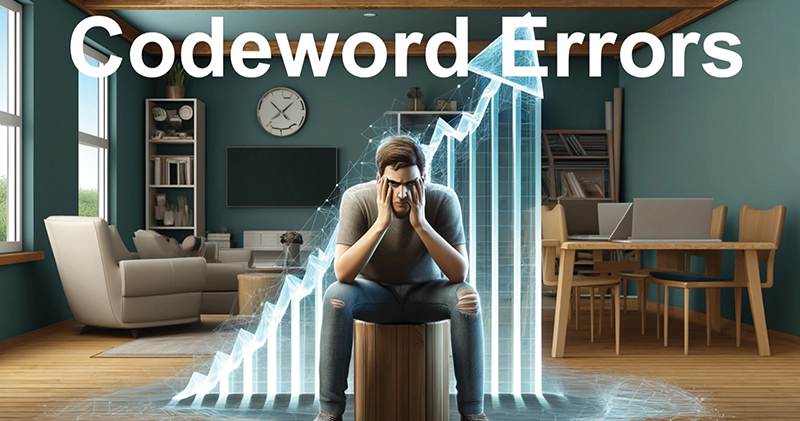The Error Era: Rethinking Codeword Calculation with OFDM and SC-QAM
By Brady Volpe
In our DOCSIS networks, accurately calculating uncorrectable codeword errors is essential for monitoring and maintaining network integrity. These errors, which cannot be corrected by the system’s error-correction algorithms, are known as uncorrectable codewords. The frequency and occurrence of uncorrectable codeword errors can signal physical or network impairments that adversely affect a subscriber’s quality of experience (QoE).
When the percentage of these errors surpasses 1%, subscribers typically experience noticeable declines in service quality, which may include slower Internet speeds, disruptions to real-time services like voice and gaming, or even complete service outages. It is vital for network operators to understand these metrics to uphold service levels and address issues swiftly. Additionally, grasping how to calculate these errors and noting the subtle differences in calculations between SC-QAM and OFDM(A) channels is key to gathering precise data and making well-informed decisions.
Importance of codeword error calculations
Uncorrectable codeword errors are a crucial diagnostic tool for detecting and pinpointing issues within a cable network. These errors may stem from a variety of causes, including noise, interference, signal attenuation, or equipment malfunctions. By consistently monitoring these errors, network operators can manage the network’s health both reactively and proactively. High levels of uncorrectable errors can lead to diminished customer satisfaction, increased subscriber turnover, and additional strain on customer support teams. Importantly, the rate of uncorrectable codeword errors is a definitive indicator of whether a subscriber is experiencing service issues. Although other metrics like RF power, RxMER, micro-reflections, and group delay are also monitored, codeword errors provide the most reliable data. In essence, when it comes to identifying service issues, codeword errors tell the true story.
SC-QAM vs. OFDM(A): Uncorrectable codeword calculation
SC-QAM Calculation
In SC-QAM systems, which have been the backbone of DOCSIS deployments up to version 3.1, data is transmitted using a single carrier per channel or spread across multiple bonded single carrier channels. The error correction employed in SC-QAM is based on Reed-Solomon codes. The formula for calculating the percentage of uncorrectable codeword errors in SC-QAM is straightforward:
Uncorrectable Codeword Errors % = (number of uncorrectable codeword errors / total number of codewords) ×100
It is important to read the details in the management information base (MIB) objects for SC-QAM codewords.
The description for docsIf3CmtsCmUsStatusUnerroreds is as follows: This attribute represents the codewords received without error from the CM on this interface. Discontinuities in the value of this counter can occur at re-initialization of the managed system, and at other times as indicated by the value of ifCounterDiscontinuityTime for the associated upstream channel.
The underlined section clarifies that in the MIB object for total codewords, the attribute named “docsIf3CmtsCmUsStatusUnerroreds” specifically counts only those codewords that are error-free. This indicates that both correctable and uncorrectable codewords are not included in what is defined as the “Total Number of Codewords” by this attribute. It’s crucial to understand that for accurate percentage calculations, the “Total Number of Codewords” in the denominator of our formula should encompass all codewords—this includes the error-free codewords, along with both correctable and uncorrectable ones, even though this comprehensive inclusion is not explicitly specified.
Here is the complete version of the SC-QAM formula for uncorrectable codeword errors, with the added clarity in the denominator:
Uncorrectable Codeword Errors % = (uncorrectable codewords / (error-free codewords + correctable codewords + uncorrectable codewords) ×100
While this appears to be a minor change, it can have a significant impact on the percentage error, depending on the variables in the denominator of the equation.
DOCSIS 3.1 OFDM and OFDMA calculation
Introduced with DOCSIS 3.1, OFDM and OFDMA represent a significant evolution in how data is transmitted over cable networks. Unlike SC-QAM, OFDM(A) employs low density parity check (LDPC) codes for error correction, which are more effective and efficient than the Reed-Solomon codes used in SC-QAM. The formula for calculating the percentage of uncorrectable codeword errors in OFDM(A) systems is like SC-QAM as follows:
Uncorrectable Codeword Errors % = (number of uncorrectable codeword errors / total number of codewords) ×100
Unlike SC-QAM, the formula for DOCSIS 3.1 OFDM and OFDMA channels does not require adding correctable and uncorrectable codewords to the denominator. This is because the MIB objects for total codewords in these channels already include all codewords—correctable, uncorrectable, and error-free—unlike SC-QAM channels, where only codewords received without error are counted in the total.
The description for docsIf31CmtsCmUsOfdmaProfileTotalCodewords is as follows:
This attribute represents the count of the total number of FEC codewords received from the CM on this Profile/Data IUC for this upstream OFDMA channel. Discontinuities in the value of this counter can occur at re-initialization of the managed system, and at other times as indicated by the value of ifCounterDiscontinuityTime for the associated upstream OFDMA channel
We can rewrite the above formula to be in alignment with SC-QAM nomenclature as:
Uncorrectable Codeword Errors % = (uncorrectable codewords / total codewords) ×100
Yielding a simple and straight forward formula.
Differences in codeword calculation
The primary differences in codeword calculation between SC-QAM and OFDM lie in the definition of the MIB objects. The performance lies in underlying technology. SC-QAM’s reliance on a single carrier makes it more vulnerable to narrowband interference and requires robust error correction across fewer, larger “blocks” of data. In contrast, OFDM’s use of multiple carriers allows it to spread the error correction load across a broader spectrum, thereby enhancing its ability to handle burst errors and deep fades, which are typical in high-speed data environments.
Furthermore, OFDM’s advanced LDPC codes provide a more granular approach to error correction, allowing for better handling of various signal degradation types without impacting the overall system performance as heavily as in SC-QAM systems.
Correctly calculating codeword error percentage is nearly identical, however, one must take summing all codewords in the SC-QAM case. DOCSIS 3.1 OFDM and OFDMA channels MIB objects went the extra step to include correctable and uncorrectable codewords in the MIB object, so no summation is necessary in the calculation.
Conclusion
The accurate calculation of uncorrectable codeword errors is crucial for managing and optimizing cable networks, especially as these networks advance with technologies such as DOCSIS 3.1 and 4.0. By effectively monitoring these errors, cable operators can maintain high-quality service and rapidly address problems that could affect subscriber QoE. The increasing adoption of OFDM and OFDMA channels in DOCSIS networks underscores the industry’s dedication to enhancing network speeds and the importance of correctly calculating data metrics.
 Brady Volpe
Brady Volpe
Mr. Volpe, the Chief Product Officer at OpenVault, brings over 30 years of experience in the broadband cable and telecommunications industry. As the founder of The Volpe Firm, Inc and Nimble This (now OpenVault), he has been instrumental in product development and successful launches. Through his acclaimed blog, podcast, and livestream, he shares expertise in high-speed data, DOCSIS, PNM, HFC, ML, PMA, RF, AI and more. Mr Volpe has an unwavering commitment to broadband innovation.
—
Image by DALLE and Author



